개념추상현실주의 화가, 개념추상 리얼리즘 회화의 개념추상 미술비평 [3] 현대미술평론가 루이, 현대미술가 개념추상리얼리즘화가 최철주의 현대미술비평과 현대미술디자인비평: 현대미술 오늘날 현대미술평론가 최철주의 미술비평 현대추상미술화가비평: 최철주 욕망개념 추상 팝아트는 상대방 욕망예술의 추상개념적 접근과 팝아트의 디자인 형태와 언어추상적 이미지를 결합한 것이다. 그의 욕망 개념, 즉 개념 추상 예술이 나타나고 형이상학적 철학적 빛 속에서 강조되는 언어적
개념추상현실주의 화가, 개념추상 리얼리즘 회화의 개념추상 미술비평 [3] 현대미술평론가 루이, 현대미술가 개념추상리얼리즘화가 최철주의 현대미술비평과 현대미술디자인비평: 현대미술 오늘날 현대미술평론가 최철주의 미술비평 현대추상미술화가비평: 최철주 욕망개념 추상 팝아트는 상대방 욕망예술의 추상개념적 접근과 팝아트의 디자인 형태와 언어추상적 이미지를 결합한 것이다. 그의 욕망 개념, 즉 개념 추상 예술이 나타나고 형이상학적 철학적 빛 속에서 강조되는 언어적 의미의 개념과 충돌하는 그림이 인공 조명으로 극적인 사건 이미지를 만들어낸다. & 현대미술의 추상회화를 디자인하는 추상 현대미술: 추상화가 루이 최철주의 현대 개념미술은 타자의 욕망을 주제로 한 비실재로서 실제적 조형성의 흔적과 가역적 빛의 음영으로 개념을 추상하는 미술이다. 이는 초기 개념미술의 개념으로 어떤 회화성의 복귀, 즉 실재의 자리를 대리하는 타자의 욕망을 추상하는 추상화다.
개념 추상 리얼리즘 회화: 개념 추상의 의미 구조로서의 이미지를 상징하는 최철주의 개념 추상 리얼리즘 회화는 실질적인 형식과 가역적인 빛의 흔적을 존재로 하여 개념을 추상화한 개념 추상 리얼리즘 미술입니다. 이것이 초기 개념 미술의 개념으로, 현실 세계를 대표하는 타인의 욕망을 추상화한 개념 추상 리얼리즘 회화입니다. 그의 리얼리즘는 추상적인 디자인 과정과 철학 이론을 통해 욕망의 시각적 표현을 탐구함으로써 언어적 의미로 구성된 매력적인 사실적 이미지이다.. 이것의 예로서의 개념추상 리얼리즘회화는: 유리창에 욕망을 비친 거울의 초상 Louis Choi Chul-joo, a portrait of a mirror reflecting its desire on the window, 113X165cm, acrylic and composite materials on cloth, 2025 & Review of Korean News Cartoon [205] Like the movie Ophelia, false love and war between countries end their deaths. (2025-5-12) / Reporter Choi Chul-joo’s Cartoon Review

Louis Choi Chul-joo, morning glory p139-1-a portrait of a mirror reflecting its desire on the window, a hand-painted picture on a computer
유리창에 욕망을 비친 거울의 초상
질료로서 거울은 유리판 뒷면에 수은(水銀)과 납의 산화물인 적색 안료를 바르고 빛을 차단해서 앞면에 대상을 비추면 빛이 반사되어 대상과 동일한 모습을 보인다.
따라서 유리 뒷면이 어두울때 거울처럼 앞면과 마주할때 자우가 바뀐 모습이 비쳐진다.
따라서 회화적 이미지는 거울 상과 동일한 모습을 관찰하여서 응시되어 보이게 그린 화폭의 이미지다.
유리에 비친 초상을 가역적 빛의 음영으로 구성된 욕망 개념의 언어적 의미를 거울의 초상화는 작은 유리를 모자이크(Mosaic)한 포토 모자이크 이미지와 동일한 구조의 이미지이다.
이것은 여러 방향의 가역적 빛의 음영으로 구성된 이미지들을 하나의 사건 장면이나 사실적 구조를 보인다.
사건 장면에 기호적 구조는 결핍된 욕망으로 주체가 분열된 이미지다. 이것은 욕망 개념의 언어적 의미와 동일시되어서 이미지의 디자인을 통해서 의미가 반복한다.
이렇게 이미지가 기호적 구조에 인과성에 따라 상징적 존재가 됨으로서 결핍된 욕망의 본질적 이미지가 유리창에 비쳐진다.
유리창은 내부와 외부를 조명의 밝기에 따라 시선을 모은다. 유리창 내부가 어두울때는 거울처럼 외부 이미지를 반사한다.
이것은 피사체로서 욕망 구조를 현상적 이미지를 도출하여서 문화적으로 결핍된 욕망 개념의 언어적 의미를 실재 구조에 맞추어 비치도록 한다.
유리창의 단면은 정지된 피사체를 반복해서 비치고 인공 조명으로 밝은 부분을 명시한다.
빛의 매체로서 공기를 품은 대기는 보는 것과 보이는 것과의 차이를 하늘 빛이 시간성과 다양한 문화적 자리에서 비롯된다.
하늘에서 가역적 빛을 보낸다. 태양에서 시작된 빛은 먼 시간에 있지만 현재의 대상을 조명한다.
이것은 지난 시간의 사건 이미지로 보여졌던 타자의 욕망을 언어적 의미와 동일한 실재 구조로 추상하여서 하늘 빛이 유리창을 투과하여서 마주친 유리창 안의 이미지와 유리창에 반사되어 유리창 앞에서 문화적 욕망의 시선으로 욕망 개념의 주체로서 결핍된 욕망의 본질적 이미지의 실체를 보여준다.
이렇게 결핍된 욕망의 주체는 상상계에서 유리창에 비친 거울의 초상을 유아처럼 자신과 동일시 한다.
유리에 비친 초상을 가역적 빛의 음영으로 자신과 동일시된 자아를 구성하고 욕망 개념의 언어적 의미를 거울의 초상은 작은 유리를 모자이크(Mosaic)한 포토 모자이크 이미지로 재현하여서 동일한 이미지로서 자아를 이룬다.
이렇게 만들어진 유리창에 비친 욕망 거울의 초상은 추상적 욕망 개념을 언어적 의미와 동일한 이미지로서의 사건 이미지나 인물의 용모가 유리창을 통해서 보이는 이미지를 욕망 개념의 의미작용으로서 그린 초상화를 구성한다.
그래서 유리창에 비친 특정된 욕망 구조를 거울에 비쳐진 초상은 시각체계에서 비존재한 추상화와 동일하다. 이것은 화폭에 그려진 욕망적 시선과 마주하는 존재로서의 현상적 구조로서 비존재하는 추상적 언어적 의미의 이미지를 실제화한다.
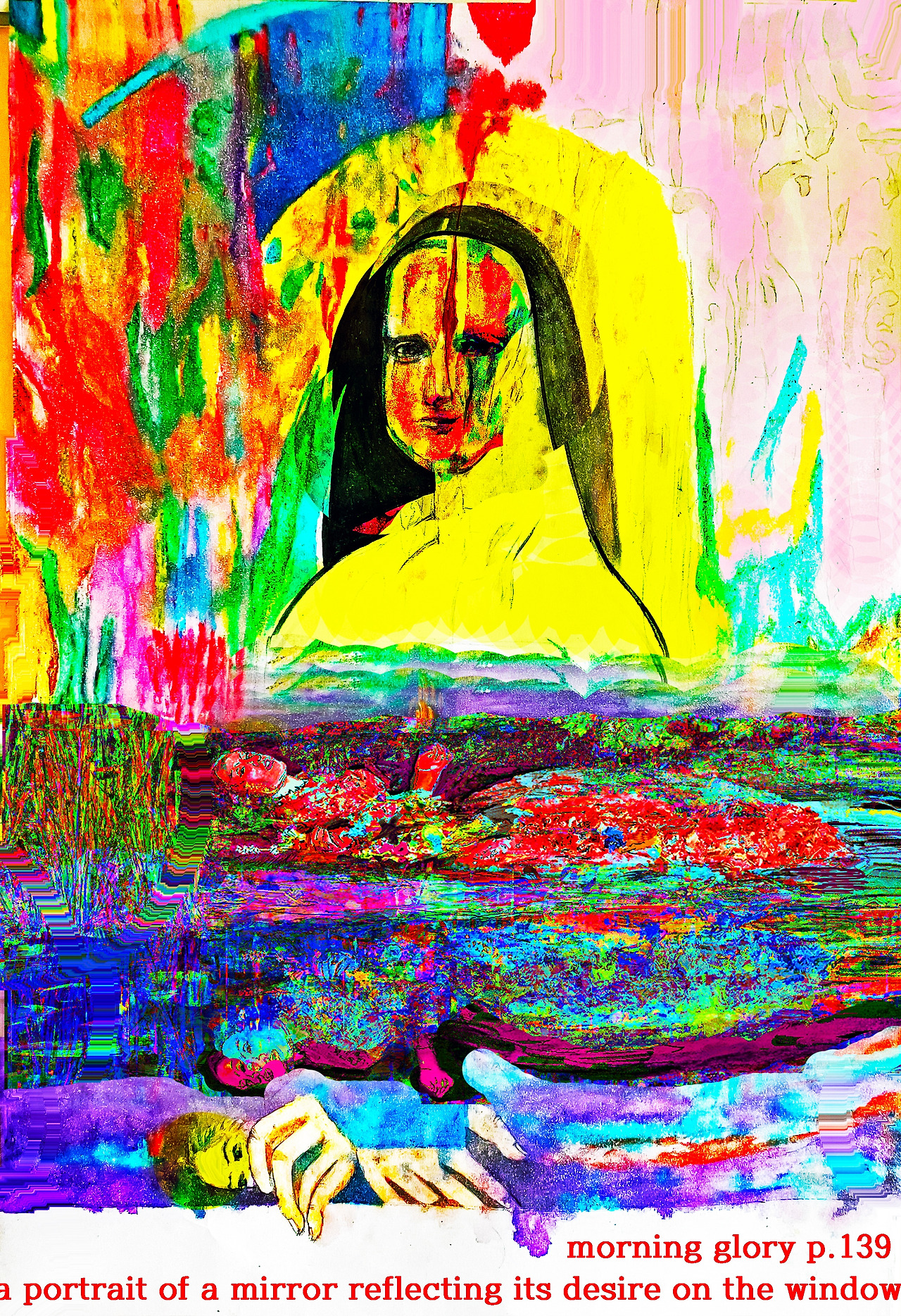
타자의 욕망과 소통하는 추상적 구조로서 욕망 개념과 추상적 존재를 동일시하려고 욕망 개념의 언어적 의미와의 소통하는 존재적 구조는 인공 조명에 따라 형태와 빛으로 고착된 병립된 색조가 다르게 보인다.
이에 따라 욕망 구조의 추상 디자인 방법은 존재적 구조를 포착하여서 실재 이미지를 가역적 빛의 음영적 색조로서 시선과 시선으로 보이는 응시적 피사체의 구조가 동일한 의미의 대상이 되도록 반복해서 디자인한다.
욕망 구조의 주체를 이미지로 그리는 것은 추상적 욕망 개념을 언어적 의미의 이미지를 러프 스케치로 연출하여서 욕망 배경을 가역적 빛의 음영으로 형태와 색조를 렌더링한다.
가역적 빛은 현상 구조를 구분하는 가시광과는 다르게 지난 시간과 공유했던 대상의 자리를 회귀한다. 이것은 어두운 유리창 표면에 조명된 방향과 정반사하거나 연못에 있는 물고기가 움직일때 빛이 꺾여서 굴절한다.
연못의 물고기가 움직일 때 어두운 창문 표면에 비추어진 방향으로 반사되거나 모양이 구부러집니다.
이렇게 욕망 구조의 주체는 가역적 빛으로 무의식 언어 의미가 이미지로 구조화된다.
그리고 특정된 욕망 구조의 결핍된 욕망을 현상적 이미지로 도출하여서 언어적 의미로 해석하여서 언어적 의미는 동일하지만 추상적 욕망 개념의 이미지는 일치할 수 없는 것을 확인한다. 따라서 욕망 개념의 언어 의미가 실재 이미지로 전이할 순 있지만 그 이미지는 추상화가 된다. 여기서 실재 이미지로서 추상화가 되려고 결핍된 욕망의 주체가 원하는 언어적 의미의 실재가 무엇인가를 특정하여서 유리창에 결핍된 욕망의 존재로서 오브제를 조각난 거울의 초상에 맞춘다.
이렇게 추상적 욕망 개념이 언어적 의미의 이미지로서 유리창에서 정반사된 대상은 좌우가 바뀌면서 실재의 대상과 마주한다.
즉 욕망 오브제로서 사건 이미지를 언어적 사회성에 따른 의미의 이미지와 동일시하여서 유리창에 가역적 빛에 반사된 거울 이미지를 타자의 욕망으로 초상한다.
언어적 의미에서 욕망 구조는 추상적 욕망 개념에서 실재 이미지와의 시가적 인식에서 상호 관계한다.
이것은 사회적 현상에서 사건 이미지와 욕망 구조와의 동일한 개념으로서의 실재의 욕망 주체를 발현한다.
가역적 빛은 보이지않는 특정된 욕망 구조 자세하게 보이면 현상적 실재되기 때문에 빛의 음영으로 실재를 추상한다.
여기서 추상적 욕망 오브제로서 사건 이미지를 그릴 때, 최철주 욕망공식을 적용한 진행은 타자의 욕망로서 특정된 현상 구조로서 특정된 추상적 욕망 개념의 언어적 의미의 욕망적 눈에 띄는 특징적인 실재로 디자인하여서 추상적 욕망 구조를 가려낸 사실적 이미지를 획득한다.
이렇게 욕망공식에 따른 추상화 디자인방법은 가역적 빛의 음영으로 특정한 추상적 욕망 개념의 언어적 의미를 은폐하여서 사실적 이미지로 추상화를 그린다.
따라서 사실적 이미지로서의 추상화는 추상적 욕망 개념에서 특정된 타자의 욕망에서 해석한 언어적 의미 즉 욕망 개념과의 상관관계로서 언어적 의미 구조가 실재 구조의 특정된 현상에서 타자의 욕망을 추상적 언어 의미가 객관적 기준에 따른 필연적 실재와의 연관관계를 가진 사건 장면으로 한 언어적 문법구조로 귀납적으로 해석한다.
그러나 실재로서 추상적 욕망 개념의 언어적 의미를 문법구조에 맞추기 어렵다. 따라서 현상적으로 볼 수 있는 추상적 욕망 개념을 형식적 문법 구조로서 문장을 만들고 생성 문법적 언어 의미를 가역적 빛으로 대비되는 음영 구조로서의 조형적 이미지로 실제화한다.
따라서 욕망 개념의 실제화 과정에서 욕망의 주체가 원하는 언어적 의미와 언표행위(enunciation)로서 특정한 결핍된 욕망의 존재로서 오브제를 실재 이미지로 전이한다.
이렇게 욕망 개념은 무의식적 언어적 의미화 과정에서 의식적 실재 구조로서의 이미지를 동일시하여서 유리창에 욕망을 비친 거울의 초상을 드러내려고 반복해서 디자인한다.
이것은 유리창에 욕망을 비친 거울의 초상처럼 보이는 인물과 그 주위 대상을 구분하지만 대상의 원근적 크기가 적용되지 않고 가역적 빛의 음영적 보색 잔상으로서 욕망 구조의 주체적 효과를 강조한다.
언어적 의미구조는 문화성에 따른 타자의 욕망 주체를 피사체로 한 추상적 이미지를 표출한다. 이것은 비현실적인 추상성을 회피하는 욕망 개념의 표상으로서 기호적 상징계를 실재 이미지로 그려짐으로써 원근법적 체계에서 벗어난 사실적 이미지가 콜라주된 추상화가 된다.
그 추상화의 기호적 주체는 욕망 개념의 언어적 의미와 동일시한 타자의 욕망과 상관관계를 이루는 상징계이다.
이것은 상징계의 기호적 주체와 욕망적 배경인 최철주의 연못 이미지와 동일시 하는 유리창에 욕망을 비친 거울의 초상이다./ 글. 현대 미술평론가 최철주 (문화디자인박사)

Louis Choi Chul-joo, a portrait of a mirror reflecting its desire on the window-sketch, 113X165cm, acrylic and composite materials on cloth, 2025
a portrait of a mirror reflecting its desire on the window
The mirror applies a red pigment, an oxide of mercury and lead, to the back of the glass plate as a material, blocking light, illuminating the object head-on and reflecting light to make it look the same as the object.
Therefore, when the back of the glass is dark, the left and right are reflected in a changed shape when looking forward like a mirror.
A picture image is an image of a canvas that has been drawn so that you can observe and see the same image as the mirror.
The linguistic meaning of the concept of desire, which consists of a glass-reflected portrait in a reversible shade of light, is an image of the same structure as a photo mosaic image of a small glass.
It shows an event scene or a realistic structure of images composed of reversible shades of light in several directions.
The symbolic structure in the scene of the event is an image in which the subject is divided by lack of desire. This is identified with the linguistic meaning of the concept of desire and the meaning is repeated through the design of the image.
In this way, as the image becomes symbolic according to causality in the symbolic structure, the essential image of the deficient desire is reflected on the window.
Windows focus their eyes on the inside and outside, depending on the brightness of light. When the inside of a window is dark, it reflects the outside image like a mirror.
This allows the structure of desire as a subject to derive a phenomenal image so that the linguistic meaning of the culturally deficient concept of desire coincides with the actual structure.
The cross section of the window repeatedly reflects a fixed subject and specifies a bright area with artificial lighting.
The atmosphere containing air as a medium of light is different from what it looks and what it looks like, and the light in the sky comes from temporal and diverse cultural positions.
It sends reversible light from the sky. The light from the sun illuminates objects that exist for a long time but are now.
This abstracts the desire of others in past event images into the same real structure as the linguistic meaning, and reflects sky light through windows and windows, showing the reality of the essential image of desire that is lacking as a conceptual subject of desire.
In this way, the subject of the absence of desire identifies the portrait of the mirror reflected in the window with oneself, like an imaginary infant.
Portraits reflected in windows form self-identity in the shade of reversible light, and the linguistic meaning of the concept of desire is reproduced as a mosaic photographic mosaic image of a small glass to form the self as the same image.
The portrait of the desire mirror in the window created in this way constitutes a portrait depicting the abstract concept of desire as an event image as the same image as the linguistic meaning, or depicting the person seen through the window as a meaningful action of the concept of desire.
Therefore, a portrait of a particular desire structure reflected in a window reflected in a mirror is like an abstract painting that does not exist in the visual system. This creates a phenomenal structure for an abstract linguistic image that does not exist as a being facing the desired gaze drawn on the canvas.
As an abstract structure that communicates with the desires of others, the existential structure that communicates with the linguistic meaning of the concept of desire to equate the concept of desire with abstract existence looks different in the hue of fixing shape and light depending on artificial lighting.
Thus, abstract design methods of desire structures capture existential structures and repeatedly design real images in reversible shades of light, so that the structure of the gaze and the gaze seen by the gaze become objects of the same meaning.
Image painting the subject of desire structure makes abstract desire concepts into rough sketches of images in the linguistic sense, making the desire background a reversible shade of light.
Unlike visible light, which distinguishes the phenomenal structure, reversible light returns to the position of an object shared with the previous time. It is reflected in the direction illuminated on the dark window surface or bent in shape as the fish in the pond moves.
In this way, the subject of the desire structure is reversible light, and the meaning of unconscious language is structured as an image.
Additionally, it is confirmed that the image of the abstract desire concept cannot match even though the linguistic meaning is the same by deriving the deficient desire of a specific desire structure as a phenomenal image and interpreting it in a linguistic sense. As a result, the image becomes abstract even though the linguistic meaning of the desire concept can be transformed into a real image.
Here, the reality of the linguistic meaning desired by the subject of desire lacking to be abstracted as a real image is specified, and the object is matched to a portrait of a carved mirror as the existence of desire lacking in the window.
In this way, the abstract concept of desire is an image in a linguistic sense, and the object reflected in the window faces the object of reality as the left and right change.
In other words, as an object of desire, the image of the event is identified with the image of meaning according to linguistic sociality, and the mirror image reflected by reversible light on the window is portrayed as the desire of the other.
In the linguistic sense, the desire structure interacts with the poetic perception of the real image in the concept of abstract desire.
In social phenomena, this expresses the subject of desire in reality as the same concept of event image and desire structure.
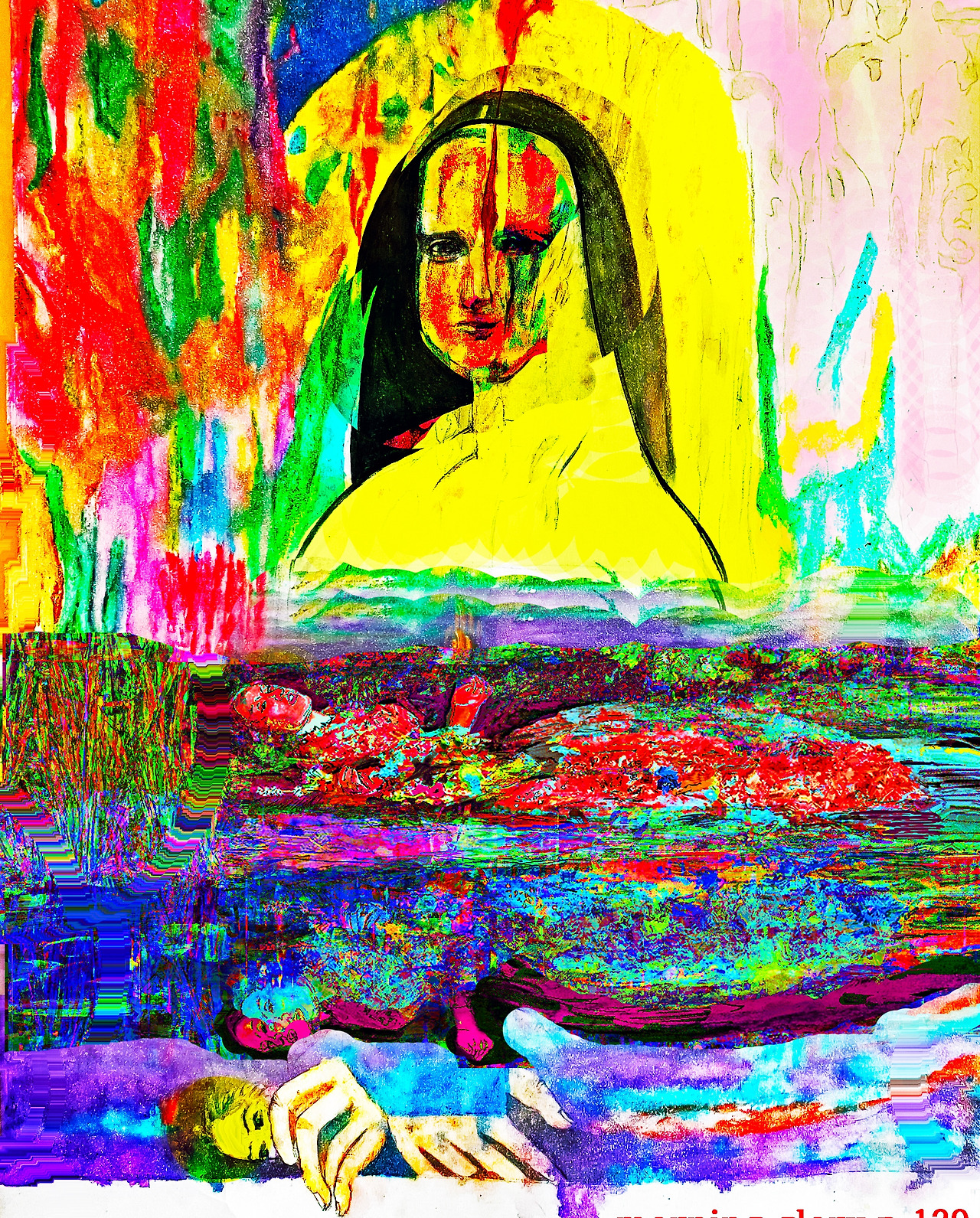
Louis Choi Chul-joo, Morning glory Poster 139 Image, a hand-painted picture on a computer
Reversible light abstracts reality as a shadow of light because it becomes phenomenal when viewed in detail as a specific invisible desire structure.
Here, when drawing an event image as an abstract desire object, the progression applying the Choi Chul-joo desire formula is designed as a desired and noticeable characteristic reality of the linguistic meaning of the abstract desire concept specified as a specific phenomenal structure of the other's desire to acquire a realistic image that obscures the abstract desire structure.
In this way, the abstract design method according to the desire formula conceals the linguistic meaning of a specific abstract desire concept with a reversible shade of light and draws abstraction as a realistic image.
Therefore, abstraction as a realistic image is a correlation between the linguistic meaning, or desire concept, interpreted from the other's desire specified in the abstract desire concept, and the linguistic meaning structure inductively interprets the other's desire as an event scene in which the abstract linguistic meaning is related to the inevitable reality based on objective standards.
However, it is challenging to match the grammatical structure with the linguistic significance of the abstract desire concept as a reality. As a result, a formal grammatical structure creates a sentence using the concept of abstract desire that can be seen as a phenomenon, and the meaning of a generated grammatical language is transformed into a formative image as a shaded structure contrasted with reversible light.
Therefore, in the process of realizing the concept of desire, the object is transferred to a real image as the existence of a specific deficient desire as an act of linguistic meaning and expression desired by the subject of desire.
In this way, the concept of desire is repeatedly designed to reveal a portrait of a mirror reflecting desire in the window by equating the image as a conscious reality structure in the process of unconscious linguistic meaning.
This distinguishes between a figure that looks like a mirror portrait of desire in a window, and the object around it, but the perspective size of the object is not applied and emphasizes the subjective effect of the desire structure as a shaded complementary color afterimage of reversible light.
The linguistic semantic structure expresses an abstract image based on the subject of the other's desire according to culturality. This is a representation of the concept of desire that avoids unrealistic abstraction, and by drawing the symbolic symbolic symbolic system as a real image, it becomes an abstraction in which a realistic image that deviates from the perspective system is collaged.
The symbolic subject of the abstraction is a symbolic system that correlates with the desire of others who identify with the linguistic meaning of the concept of desire.
This is a portrait of a mirror reflecting desire on a window that identifies the symbolic subject of the symbolic world and the image of Choi Chul-joo's pond, the background of desire./ Writing. Choi Chul-joo, a contemporary art critic (Doctor of Cultural Design)
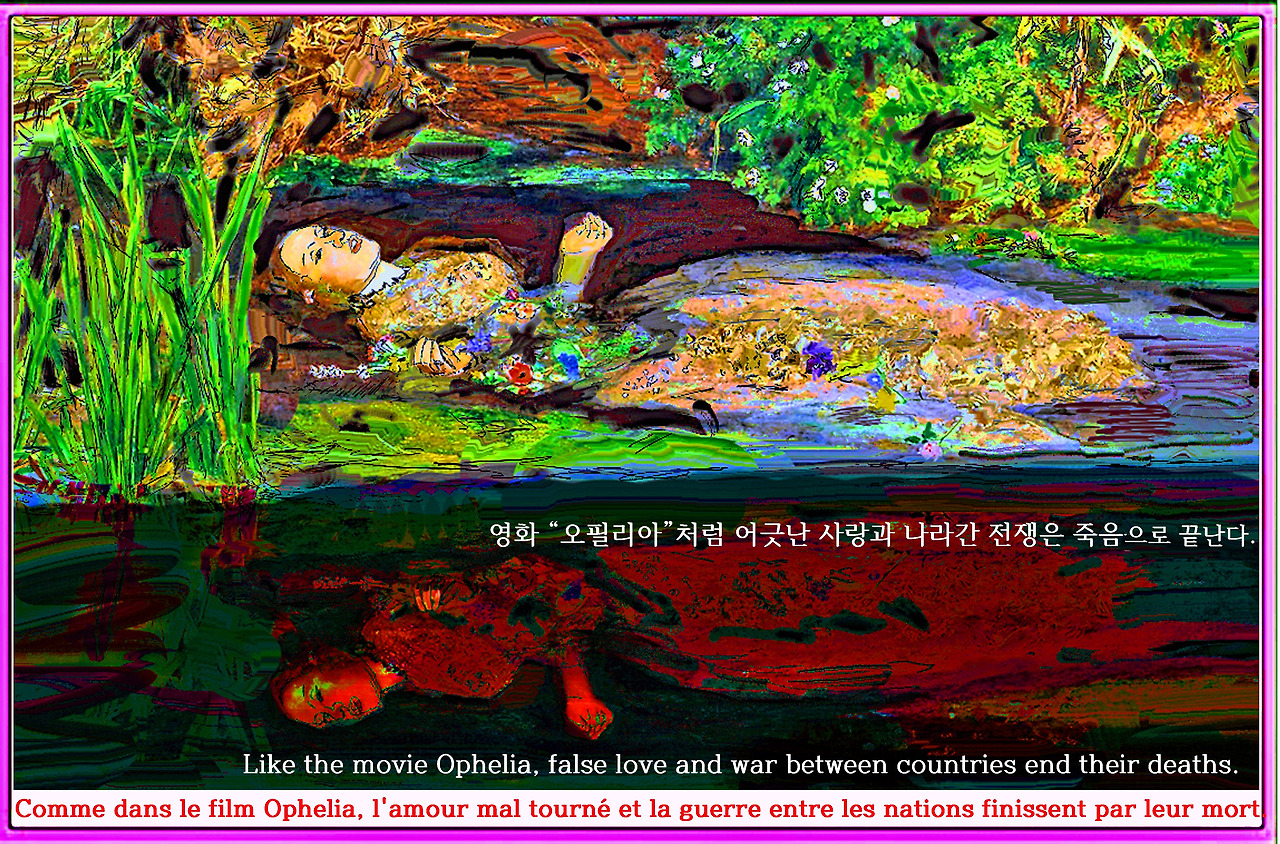
Louis Choi Chul-joo, Like the movie Ophelia, false love and war between countries end their deaths, a hand-painted picture on a computer: Review of Korean News Cartoon [205] Like the movie Ophelia, false love and war between countries end their deaths. (2025-5-12) / Reporter Choi Chul-joo’s Cartoon Review
Cartoonist Choi Chul-joo's comic abstraction as a treacherous conceptual art means the abstraction of the conceptual image of desire as a realistic structure in art. Since the conceptual meaning of desire that exists in place of a realistic form can be divided into a cartoon criticism image, abstraction is drawn through reversible contrast that interprets the image of events and performances as an image of others' abstract desires.
Choi Chul joo cartoon review, which uses contemporary art abstraction as a treacherous conceptual art, reinterprets the image of desire as a concept of cartoon.
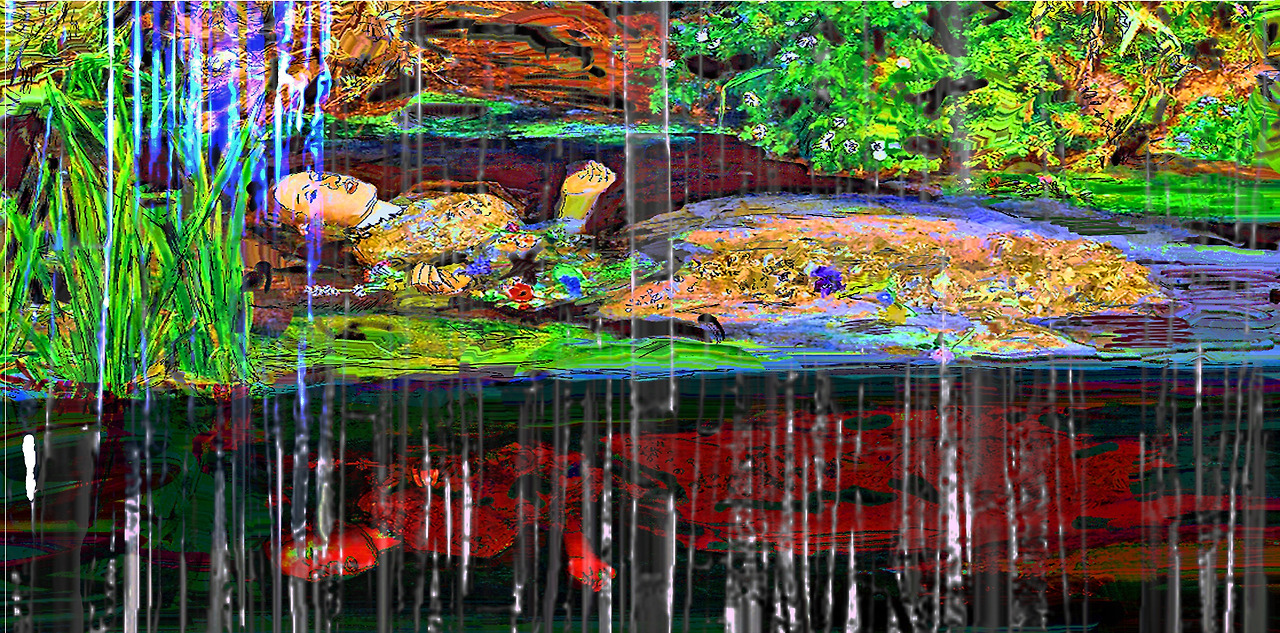
Desire Concept Realistic Abstract Work: Louis Choi Chul-joo, bamboo forest 262-Like the movie Ophelia, false love and war between countries end their deaths, a hand-painted picture on a computer: By repeatedly applying the concept of imaginary world and desire and Choi Chul-joo's desire formula <D(I...I')d=I(D...D'i)i> to the image of the work, it acquires aesthetic value and reveals its meaning by realizing formability in the shadow of reversible light. / The meaning of the shape, which is covered by the actual changed instantaneous movement of the shape, results in linguistic abstraction. In other words, the realistic shape of the other person's desire in a momentary event is a linguistic abstraction of the same meaning. Conceptual art with morning glory and bamboo as cultural background is linguistic abstraction. The abstract creates a conceptual structure based on the shape of subsequent reality fostered by language and hides the desire of others in a momentary event.
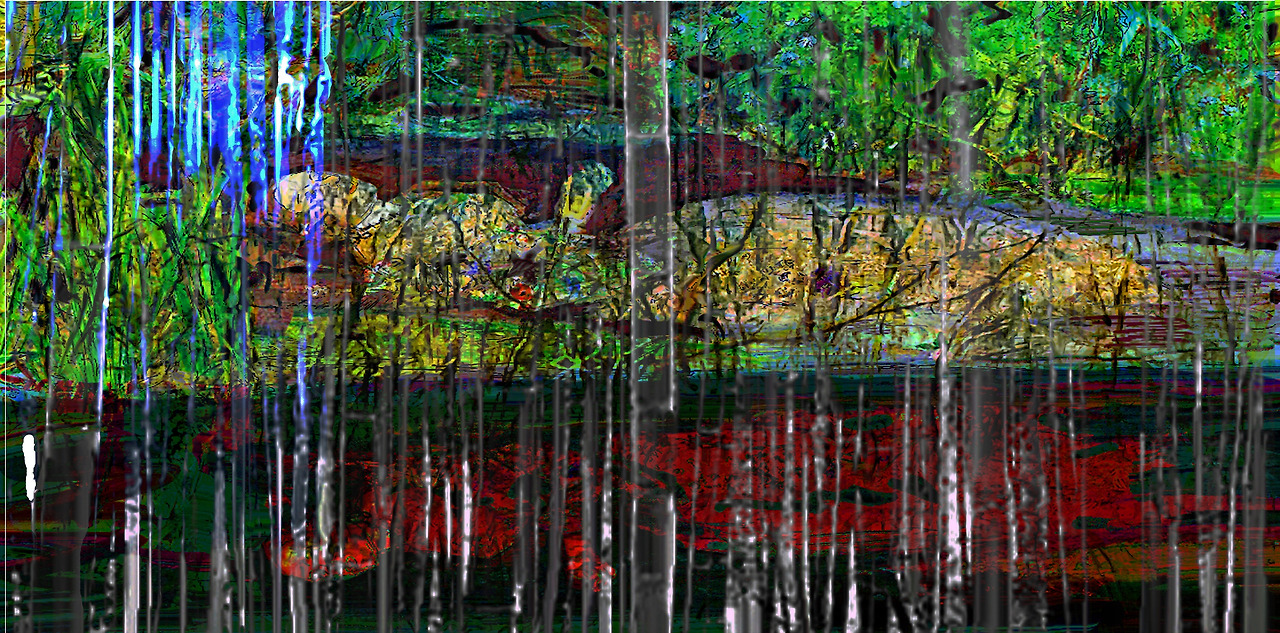
Desire Concept Realistic Abstract Work: Louis Choi chuljoo, bamboo forest b262-Like the movie Ophelia, false love and war between countries end their deaths: By repeatedly applying the concept of imaginary world and desire and Choi Chul-joo's desire formula <D(I...I')d=I(D...D'i)i> to the image of the work, it acquires aesthetic value and reveals its meaning by realizing formability in the shadow of reversible light. / The meaning of the shape, which is covered by the actual changed instantaneous movement of the shape, results in linguistic abstraction. In other words, the realistic shape of the other person's desire in a momentary event is a linguistic abstraction of the same meaning. Conceptual art with morning glory and bamboo as cultural background is linguistic abstraction. The abstract creates a conceptual structure based on the shape of subsequent reality fostered by language and hides the desire of others in a momentary event.
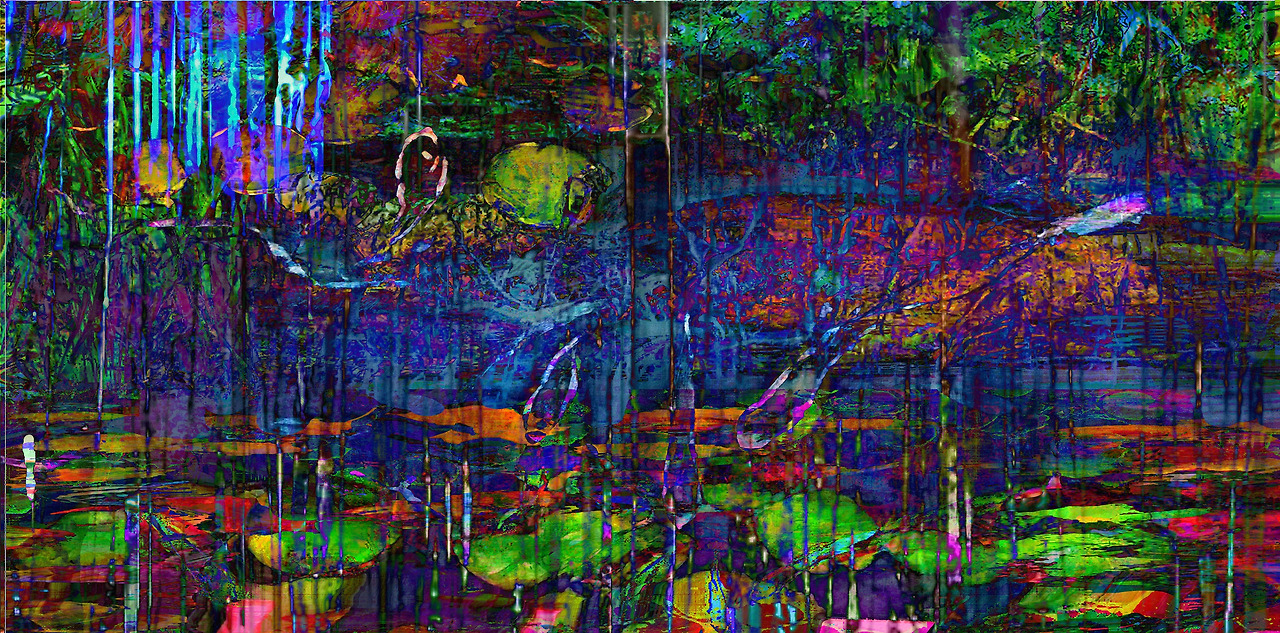
The visualization of the concept of desire: Louis Choi chuljoo, ba-pondmboo forest b262-Like the movie Ophelia, false love and war between countries end their deaths-pond: Visualizing the concept of desire is a cartoon depicting events and performances manually, expressing the background of the cartoon as a landscape of desire with "Bamboo Forest," and the cartoon image reconstructs desire into an abstract and realistic picture.
Desire Design Methodology in Abstract Art Theory on Painting Design, Contemporary Artist Choi Chul-joo's Desire Concept Abstract Design Methodology: <bamboo forest b262-Like the movie Ophelia, false love and war between countries end their deaths> As an Abstract Korean painting of Modern Art, Desire Formula <D(I...I')d=I(D...D'i)i> is applied to overlap the painting <2024 U.S. presidential candidate> created by reversible light. In addition, by re-applying the desire formula by linking verbal metaphor images, a phenomenal conceptual place is set in another place in one space as a shade of reversible light and abstracted.
This translates to the first non-realistic abstraction poster at Louis Choi Chul-joo's 2022 New York Exhibition to actualize the Desire Object. The image <bamboo forest d204-pond-2024 U.S. presidential candidate> becomes a non-real abstraction of reality.
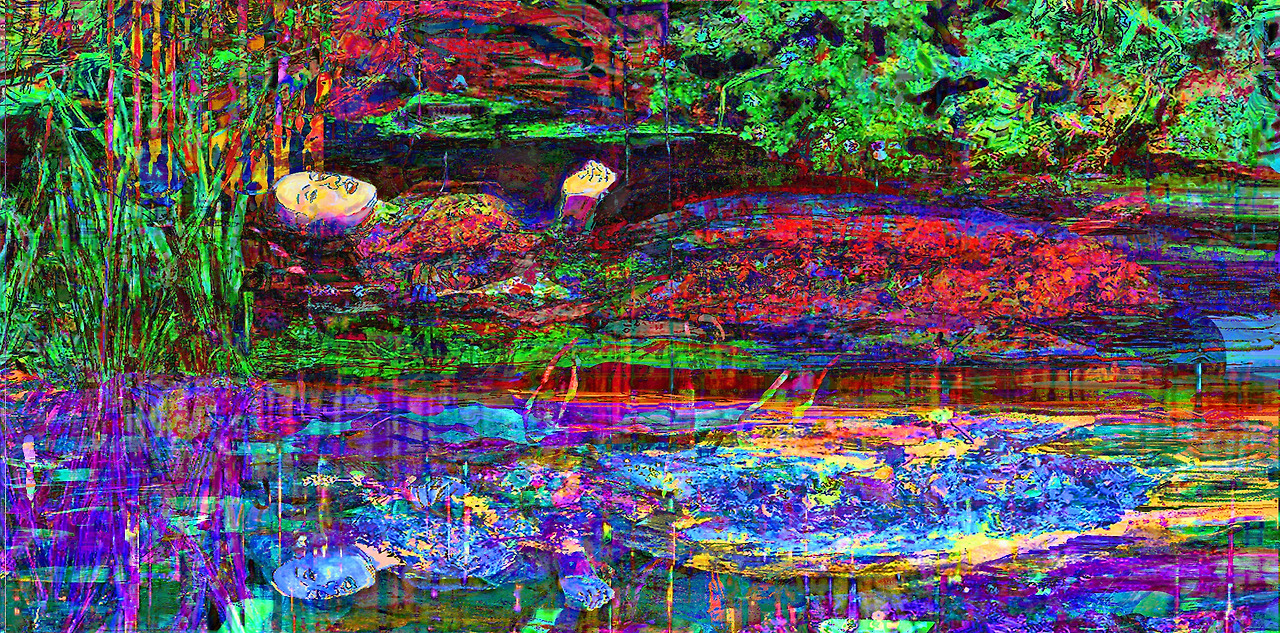
Desire Concept Realistic Abstract Work: Louis Choi chuljoo, bamboo forest b262-Like the movie Ophelia, false love and war between countries end their deaths-pond-mirror: By repeatedly applying the concept of imaginary world and desire and Choi Chul-joo's desire formula <D(I...I')d=I(D...D'i)i> to the image of the work, it acquires aesthetic value and reveals its meaning by realizing formability in the shadow of reversible light. / The meaning of the shape, which is covered by the actual changed instantaneous movement of the shape, results in linguistic abstraction. In other words, the realistic shape of the other person's desire in a momentary event is a linguistic abstraction of the same meaning. Conceptual art with morning glory and bamboo as cultural background is linguistic abstraction. The abstract creates a conceptual structure based on the shape of subsequent reality fostered by language and hides the desire of others in a momentary event.
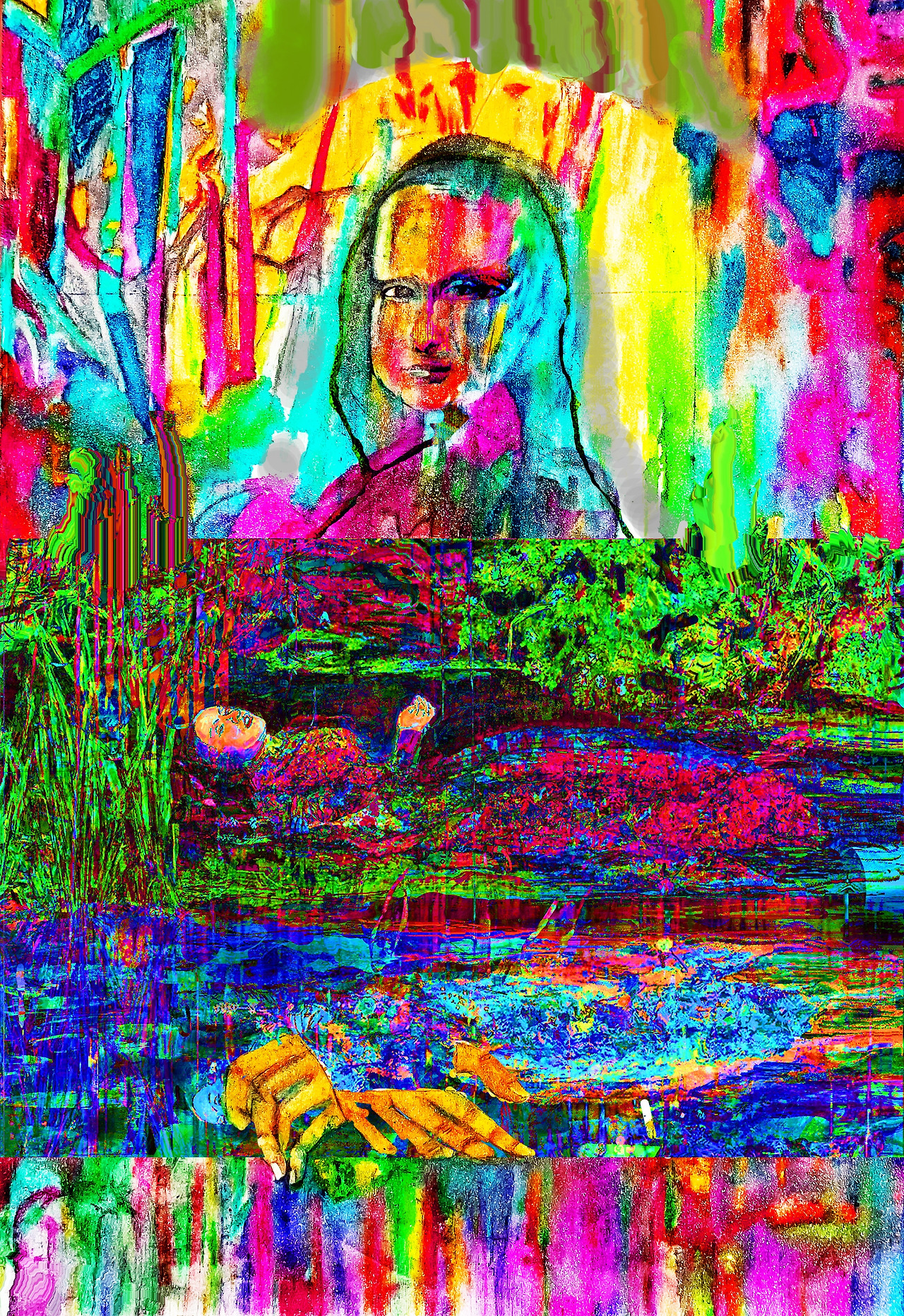
Desire Concept Realistic Abstract Work: Louis Choi chuljoo, morning glory p138-4-Like the movie Ophelia, false love and war between countries end their deaths: By repeatedly applying the concept of imaginary world and desire and Choi Chul-joo's 3formula <D(I...I')d=I(D...D'i)i> to the image of the work, it acquires aesthetic value and reveals its meaning by realizing formability in the shadow of reversible light. / The meaning of the shape, which is covered by the actual changed instantaneous movement of the shape, results in linguistic abstraction. In other words, the realistic shape of the other person's desire in a momentary event is a linguistic abstraction of the same meaning. Conceptual art with morning glory and bamboo as cultural background is linguistic abstraction. The abstract creates a conceptual structure based on the shape of subsequent reality fostered by language and hides the desire of others in a momentary event.
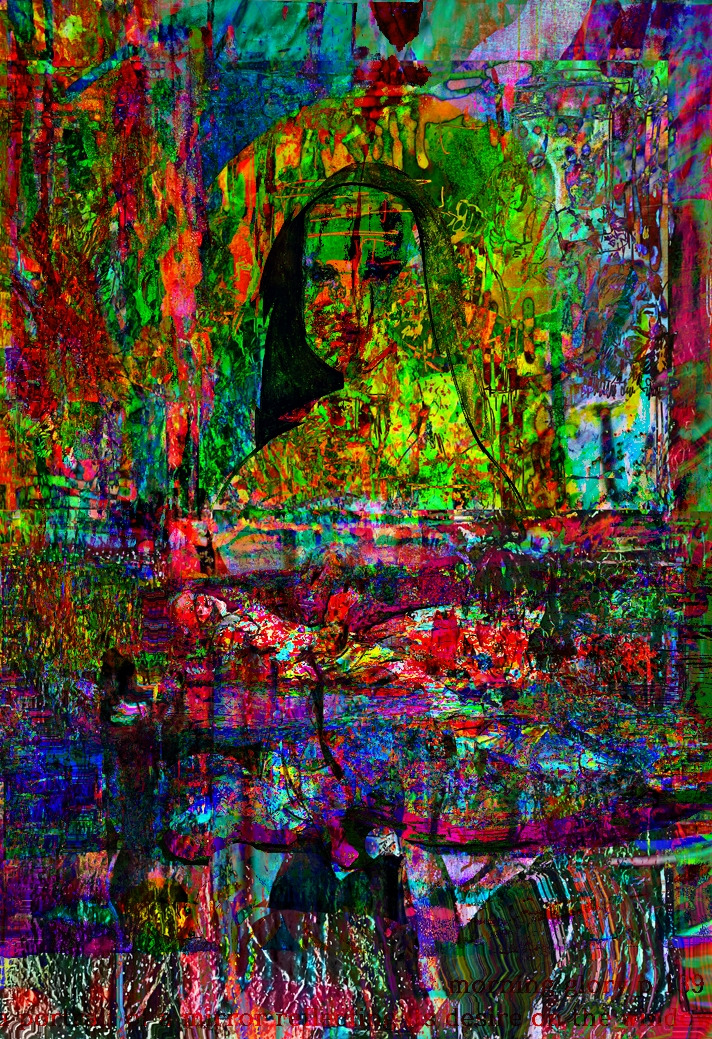
Louis Choi Chul-joo, morning glory p139-1-a portrait of a mirror reflecting its desire on the window, a hand-painted picture on a computer
Cartoonist Choi Chul-joo's Desire Conceptual Art Cartoon abstraction as a cartoonist means abstracting the conceptual image of desire in art into a realistic structure. Since the conceptual meaning of desire that exists instead of a realistic form can be divided into cartoon criticism images, poster abstraction that designates specific places is drawn through reversible contrast that interprets images of events and performances as images of abstract desires of others.
Choi Chul-joo cartoon review and abstraction "morning glory", which use modern art poster abstraction as desire conceptual art, abstracts the image of the concept of desire by reinterpreting it as a concept of cartoon.

Desire Concept Realistic Abstract Work: Louis Choi Chul-joo, bamboo forest 267-a portrait of a mirror reflecting its desire on the window, a hand-painted picture on a computer: By repeatedly applying the concept of imaginary world and desire and Choi Chul-joo's desire formula <D(I...I')d=I(D...D'i)i> to the image of the work, it acquires aesthetic value and reveals its meaning by realizing formability in the shadow of reversible light. / The meaning of the shape, which is covered by the actual changed instantaneous move

Desire Concept Realistic Abstract Work: Louis Choi Chul-joo, bamboo forest i267-a portrait of a mirror reflecting its desire on the window, a hand-painted picture on a computer: By repeatedly applying the concept of imaginary world and desire and Choi Chul-joo's desire formula <D(I...I')d=I(D...D'i)i> to the image of the work, it acquires aesthetic value and reveals its meaning by realizing formability in the shadow of reversible light. / The meaning of the shape, which is covered by the actual changed instantaneous movement of the shape, results in linguistic abstraction. In other words, the realistic shape of the other person's desire in a momentary event is a linguistic abstraction of the same meaning. Conceptual art with morning glory and bamboo as cultural background is linguistic abstraction. The abstract creates a conceptual structure based on the shape of subsequent reality fostered by language and hides the desire of others in a momentary event.
■ Choi Chul-joo's concept of desire design process "morning glory" by Choi Chul-joo is a reconstruction of the imagination of desire that is recognized as a structure of desire and the reality reflected in the mirror as a background of desire established as a visual structure. "Bamboo Forest" is the shadow that hides the reality in the shadow of reversible light in his desire concept design process. And "The Missing Pond" is an abstract language image that reflects the reality of the concept of unconscious desire as a linguistic structure.
Therefore, Choi Chul-joo's concept of desire visualizes the concept of desire as a linguistic representation of the "disappeared pond" structure of symbolic reality, reducing the concept of abstract desire to a real image in the category of modern art's ideal Logos expression.
The progress of this symbolizes the object of desire as a conceptual subject as a design process of the conceptual subject of desire.
Choi Chul-joo's concept of desire to design abstraction in contemporary art does not presuppose causality with the real image, but symbolizes the object of desire as a conceptual subject from an abstract concept in which desires alienated by the unconscious are divided, resulting in an abstract real image as a correlation between real images.
In linguistic abstraction, the meaning of abstraction as a real image is inductively inferred to take the meaning of symbolic existence.
And the view of the image of its existence abstracts the concept of desire to the outside of reality, and the real image becomes the object of abstraction as the correlation of reality with the concept of desire. This is Choi Chul-joo's concept of desire design process 1.
The actual image symbolized by the design using the object of abstract desire as the conceptual subject is omitted, and the image is flattened in the visible range of light. And the image is represented as a symbolic structure of the concept of desire, which is spoken in a linguistic sense.
Choi Chul-joo's concept of desire design process 2 is to decorate the object with a color of universal reality that matches customs so that the reality of the symbolic structure represented in this way has an aesthetic value corresponding to the place as a single image.
The aesthetic structure concealed by the image designed as the concept of desire is divided into clouds and obscured shades, and the concept of desire is visualized as an image in various directions in the opposite direction of the concept of desire and the image, and the subject of the structure of desire created in the social environment is represented as an object in the past to recognize the image as an abstraction. And the subject who drew the existence executes the reality that symbolizes the concept of desire as an agent, and turns abstract desire into an image's mental phenomenon.
And Choi Chul-joo's abstract concept of desire is created by the imagination desired by the subject of desire in selecting an image of an abstract desire object in the unconscious.
As an abstract image, the concept of desire design process 3 is to repeatedly design a desire that combines lines and colors as an unconscious act that is in thought but is not conscious.
The concept of unconsciously abstracting desire is a sculpture image of reality in which the object of reality is not seen as a reversible shadow of light, and shows another image of reality by concealing reality as a shadow.
The image is an unconscious mind maintained by the real image and the imagination desired by the subject of desire, and is an idea that cannot be recognized by that image.
Desire Concept Design Process 4. is designed by combining the spatial composition of desire, in which the image of desire is a sculpted planar monochromatic painting in reality, into a reversible structure of light through conscious movement.
In this way, Choi Cheol-joo's concept of desire design appears as an object of desire as another abstract reality in the perspective visual system through his concept of desire design process.
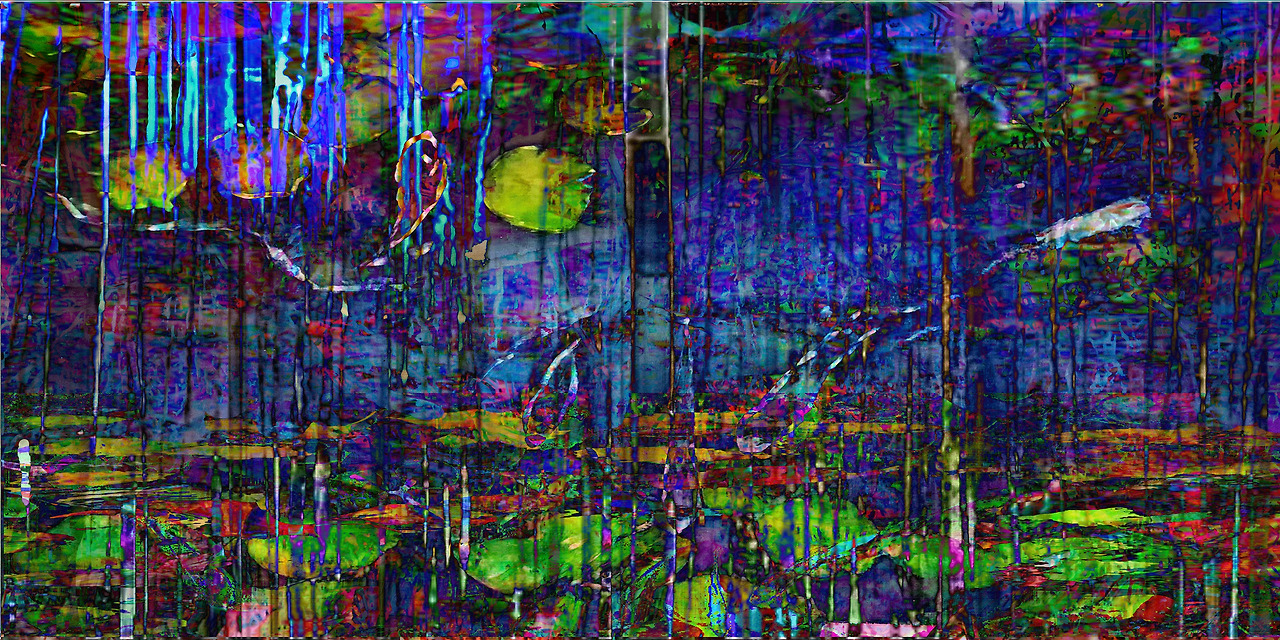
The visualization of the concept of desire: Louis Choi chuljoo, ba-pondmboo forest i267-a portrait of a mirror reflecting its desire on the window-pond: Visualizing the concept of desire is a cartoon depicting events and performances manually, expressing the background of the cartoon as a landscape of desire with "Bamboo Forest," and the cartoon image reconstructs desire into an abstract and realistic picture./ The meaning of the shape, which is covered by the actual changed instantaneous movement of the shape, results in linguistic abstraction. In other words, the realistic shape of the other person's desire in a momentary event is a linguistic abstraction of the same meaning. Conceptual art with morning glory and bamboo as cultural background is linguistic abstraction. The abstract creates a conceptual structure based on the shape of subsequent reality fostered by language and hides the desire of others in a momentary event.
Desire Design Methodology in Abstract Art Theory on Painting Design, Contemporary Artist Choi Chul-joo's Desire Concept Abstract Design Methodology: <bamboo forest i267-a portrait of a mirror reflecting its desire on the window> As an Abstract Korean painting of Modern Art, Desire Formula <D(I...I')d=I(D...D'i)i> is applied to overlap the painting <2024 U.S. presidential candidate> created by reversible light. In addition, by re-applying the desire formula by linking verbal metaphor images, a phenomenal conceptual place is set in another place in one space as a shade of reversible light and abstracted.
This translates to the first non-realistic abstraction poster at Louis Choi Chul-joo's 2022 New York Exhibition to actualize the Desire Object. The image <bamboo forest d204-pond-2024 U.S. presidential candidate> becomes a non-real abstraction of reality.
By repeatedly applying the concept of imaginary world and desire and Choi Chul-joo's desire formula <D(I...I')d=I(D...D'i)i> to the image of the work, it acquires aesthetic value and reveals its meaning by realizing formability in the shadow of reversible light. / The meaning of the shape, which is covered by the actual changed instantaneous movement of the shape, results in linguistic abstraction. In other words, the realistic shape of the other person's desire in a momentary event is a linguistic abstraction of the same meaning. Conceptual art with morning glory and bamboo as cultural background is linguistic abstraction. The abstract creates a conceptual structure based on the shape of subsequent reality fostered by language and hides the desire of others in a momentary event.
■ Choi Chul-joo's concept of desire design process "morning glory" by Choi Chul-joo is a reconstruction of the imagination of desire that is recognized as a structure of desire and the reality reflected in the mirror as a background of desire established as a visual structure. "Bamboo Forest" is the shadow that hides the reality in the shadow of reversible light in his desire concept design process. And "The Missing Pond" is an abstract language image that reflects the reality of the concept of unconscious desire as a linguistic structure.
Therefore, Choi Chul-joo's concept of desire visualizes the concept of desire as a linguistic representation of the "disappeared pond" structure of symbolic reality, reducing the concept of abstract desire to a real image in the category of modern art's ideal Logos expression.
The progress of this symbolizes the object of desire as a conceptual subject as a design process of the conceptual subject of desire.
Choi Chul-joo's concept of desire to design abstraction in contemporary art does not presuppose causality with the real image, but symbolizes the object of desire as a conceptual subject from an abstract concept in which desires alienated by the unconscious are divided, resulting in an abstract real image as a correlation between real images.
In linguistic abstraction, the meaning of abstraction as a real image is inductively inferred to take the meaning of symbolic existence.
And the view of the image of its existence abstracts the concept of desire to the outside of reality, and the real image becomes the object of abstraction as the correlation of reality with the concept of desire. This is Choi Chul-joo's concept of desire design process 1.
The actual image symbolized by the design using the object of abstract desire as the conceptual subject is omitted, and the image is flattened in the visible range of light. And the image is represented as a symbolic structure of the concept of desire, which is spoken in a linguistic sense.
Choi Chul-joo's concept of desire design process 2 is to decorate the object with a color of universal reality that matches customs so that the reality of the symbolic structure represented in this way has an aesthetic value corresponding to the place as a single image.
The aesthetic structure concealed by the image designed as the concept of desire is divided into clouds and obscured shades, and the concept of desire is visualized as an image in various directions in the opposite direction of the concept of desire and the image, and the subject of the structure of desire created in the social environment is represented as an object in the past to recognize the image as an abstraction. And the subject who drew the existence executes the reality that symbolizes the concept of desire as an agent, and turns abstract desire into an image's mental phenomenon.
And Choi Chul-joo's abstract concept of desire is created by the imagination desired by the subject of desire in selecting an image of an abstract desire object in the unconscious.
As an abstract image, the concept of desire design process 3 is to repeatedly design a desire that combines lines and colors as an unconscious act that is in thought but is not conscious.
The concept of unconsciously abstracting desire is a sculpture image of reality in which the object of reality is not seen as a reversible shadow of light, and shows another image of reality by concealing reality as a shadow.
The image is an unconscious mind maintained by the real image and the imagination desired by the subject of desire, and is an idea that cannot be recognized by that image.
Desire Concept Design Process 4. is designed by combining the spatial composition of desire, in which the image of desire is a sculpted planar monochromatic painting in reality, into a reversible structure of light through conscious movement.
In this way, Choi Cheol-joo's concept of desire design appears as an object of desire as another abstract reality in the perspective visual system through his concept of desire design process.
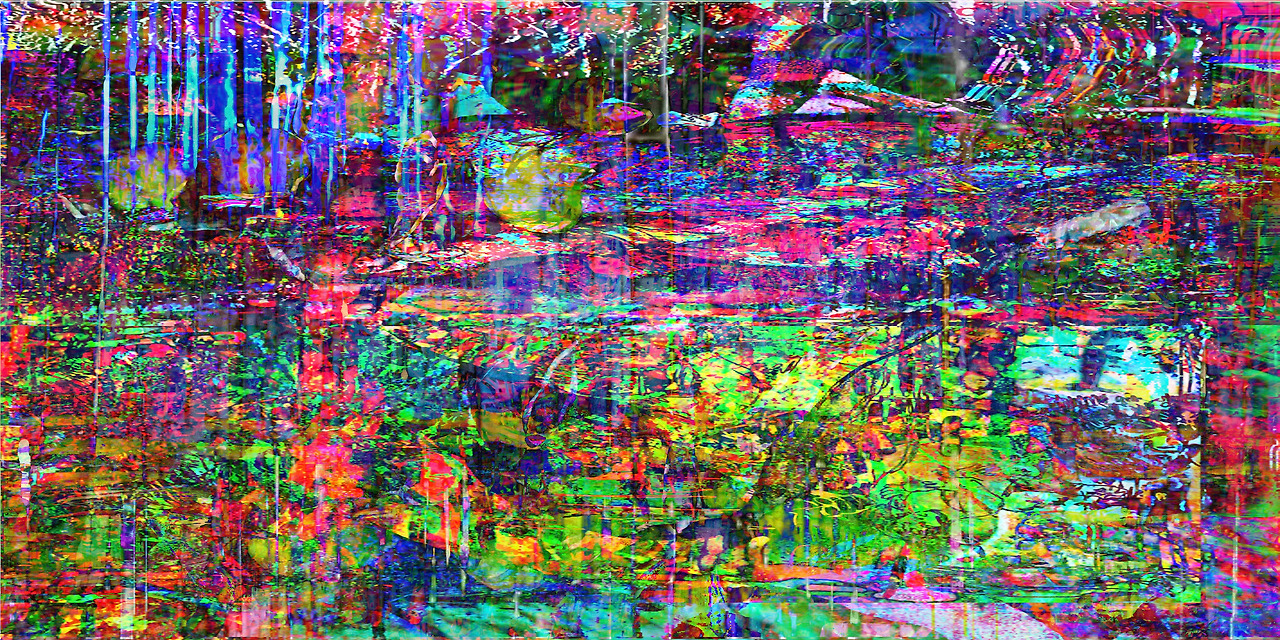
Desire Concept Realistic Abstract Work: Louis Choi chuljoo, bamboo forest i267-a portrait of a mirror reflecting its desire on the window-pond-mirror: By repeatedly applying the concept of imaginary world and desire and Choi Chul-joo's desire formula <D(I...I')d=I(D...D'i)i> to the image of the work, it acquires aesthetic value and reveals its meaning by realizing formability in the shadow of reversible light. / The meaning of the shape, which is covered by the actual changed instantaneous movement of the shape, results in linguistic abstraction. In other words, the realistic shape of the other person's desire in a momentary event is a linguistic abstraction of the same meaning. Conceptual art with morning glory and bamboo as cultural background is linguistic abstraction. The abstract creates a conceptual structure based on the shape of subsequent reality fostered by language and hides the desire of others in a momentary event.
The visualization of the concept of desire: Visualizing the concept of desire is a cartoon depicting events and performances manually, expressing the background of the cartoon as a landscape of desire with "Bamboo Forest," and the cartoon image reconstructs desire into an abstract and realistic picture.
Desire Design Methodology in Abstract Art Theory on Painting Design, Contemporary Artist Choi Chul-joo's Desire Concept Abstract Design Methodology: < > As an Abstract Korean painting of Modern Art, Desire Formula <D(I...I')d=I(D...D'i)i> is applied to overlap the painting < Louis Choi Chul-joo, morning glory p139-1-a portrait of a mirror reflecting its desire on the window, a hand-painted picture on a computer> created by reversible light.
Therefore, conceptual abstract painter Louis Choi Chul-joo's "bamboo forest i267-a portrait of a mirror reflecting its desire on the window" is a desire image of a real structure that is reconstructed into a reversible structure of light as an image of the concept of desire
By repeatedly applying the concept of imaginary world and desire and Choi Chul-joo's desire formula <D(I...I')d=I(D...D'i)i> to the image of the work, it acquires aesthetic value and reveals its meaning by realizing formability in the shadow of reversible light. / The meaning of the shape, which is covered by the actual changed instantaneous movement of the shape, results in linguistic abstraction. In other words, the realistic shape of the other person's desire in a momentary event is a linguistic abstraction of the same meaning. Conceptual art with morning glory and bamboo as cultural background is linguistic abstraction. The abstract creates a conceptual structure based on the shape of subsequent reality fostered by language and hides the desire of others in a momentary event.

Desire Concept Realistic Abstract Work: Louis Choi Chul-joo, morning glory p139-1-a portrait of a mirror reflecting its desire on the window, a hand-painted picture on a computer : By repeatedly applying the concept of imaginary world and desire and Choi Chul-joo's 3formula <D(I...I')d=I(D...D'i)i> to the image of the work, it acquires aesthetic value and reveals its meaning by realizing formability in the shadow of reversible light. / The meaning of the shape, which is covered by the actual changed instantaneous movement of the shape, results in linguistic abstraction. In other words, the realistic shape of the other person's desire in a momentary event is a linguistic abstraction of the same meaning. Conceptual art with morning glory and bamboo as cultural background is linguistic abstraction. The abstract creates a conceptual structure based on the shape of subsequent reality fostered by language and hides the desire of others in a momentary event.
By repeatedly sketching design and applying Choi Chuljoo's desire formula "D(I...I')d=I(D...D'i)i" to the conceptual image of desire, it instantly acquires aesthetic value and reveals the meaning of abstract desire by realizing realistic formability in the shadow of reversible light at that moment. / The abstract meaning of the shape in which the actual changed instantaneous desire shape is hidden by the reversible movement of light results in linguistic abstraction. In other words, it is verbal abstraction with the same meaning as a realistic form of the other person's desire in a momentary event or performance scene. Choi Chul-joo's conceptual art with morning glory and bamboo as the background of cultural abstraction is the linguistic abstraction of images. The abstraction creates a conceptual structure based on the shape of reality after the meaning fostered by language and hides the abstract desire of others in momentary events and performance scenes.
Louis Choi Chul-joo,"morning glory p139-1-a portrait of a mirror reflecting its desire on the window," is a desire image of a real structure that is reconstructed into a reversible structure of light as an image of the concept of desire created from a transformed image meaning the reality of morning glory.
Conceptual Abstract Painter Louis Choi Chul-joo's work "bamboo forest i267-a portrait of a mirror reflecting its desire on the window-pond-mirror" rather than campaign broadcasts through YouTube-pond-mirror" is an abstract reality image that reconstructs the structure of desire created through an aesthetic grammatical structure into a linguistic sense.

Louis Choi chuljoo, morning glory p139-a portrait of a mirror reflecting its desire on the window, a hand-painted picture on a computer
Desire Concept Realistic Abstract Work: Louis Choi chuljoo, morning glory p139-a portrait of a mirror reflecting its desire on the window: By repeatedly applying the concept of imaginary world and desire and Choi Chul-joo's desire formula <D(I...I')d=I(D...D'i)i> to the image of the work, it acquires aesthetic value and reveals its meaning by realizing formability in the shadow of reversible light. / The meaning of the shape, which is covered by the actual changed instantaneous movement of the shape, leads to verbal abstraction. In other words, the shape in which the other's desire is realistically revealed in a momentary event is a linguistic abstraction with the same meaning. Conceptual art with morning glory and bamboo as a cultural background is linguistic abstraction. Abstraction creates a conceptual structure reflected in a pond based on the shape of subsequent reality fostered by language and hides the desires of others in instantaneous events.And Choi Chul-joo's concept of desire visualizes the concept of desire as a linguistic expression for "morning glory" reflected in the "pond" structure of symbolic reality, reducing the abstract concept of desire to a real image in the category of ideal desire expression in contemporary art.
In addition, as a process of designing the concept of desire, the object of desire is symbolized as a conceptual subject, forming a reality expressed through desire revealed in the oppressed unconscious through design and revealing abstraction as existence

The visualization of the concept of desire: Conceptual Visualization of Desire is a cartoon abstraction that describes events and performances as a concept of desire, which expresses the image of events as a desire background "morning glory" and "Bamboo Forest" as the background of the cartoon, and reconstructs the cartoon image as a realistic picture by moving it from the concept of abstract desire to the desire background "morning glory" and "Bamboo Forest," which are the subjects of desire.
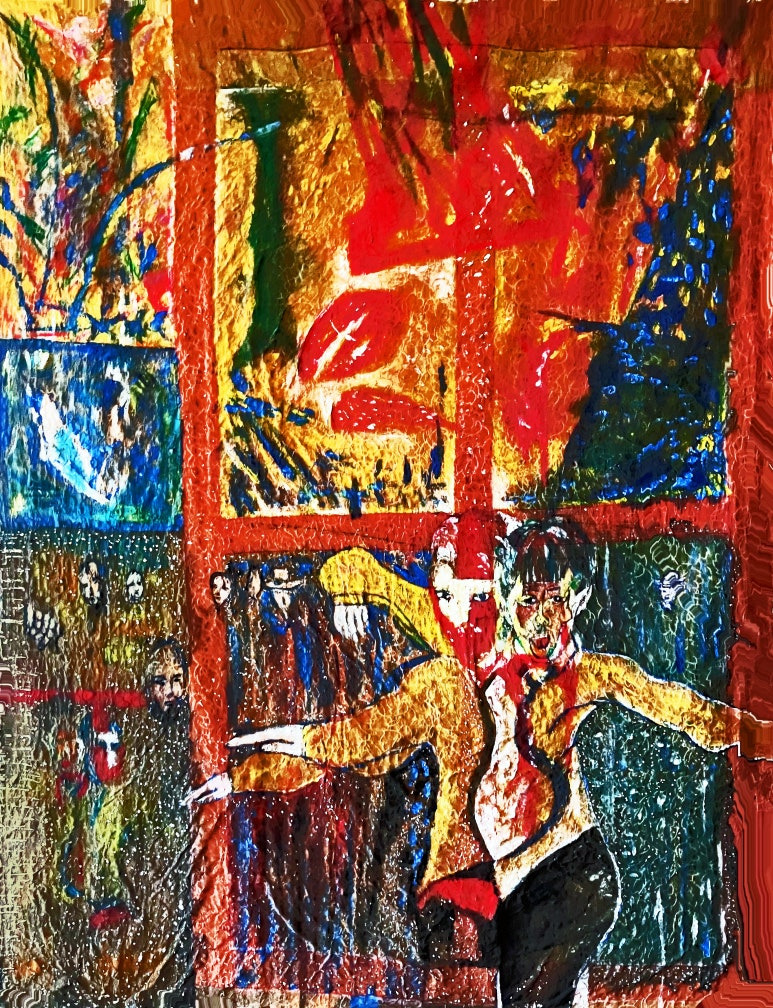
Louis Chul-joo Choi, Rendering the intersection of desire outside the window, 140X186cm, acrylic and composite materials on cloth, 2024
Contemporary Artist Choi Chul-joo's Desire Concept Abstract Design Methodology: <morning glory p139-a portrait of a mirror reflecting its desire on the window, a hand-painted picture on a computer> As an Abstract Korean painting of Modern Art, Desire Formula <D(I...I')d=I(D...D'i)i> is applied to overlap the painting <Louis Chul-joo Choi, Rendering the intersection of desire outside the window, 140X186cm, acrylic and composite materials on cloth, 2024> created by reversible light. In addition, by re-applying the desire formula by linking verbal metaphor images, a phenomenal conceptual place is set in another place in one space as a shade of reversible light and abstracted.
This translates to the first non-realistic abstraction poster at Louis Choi Chul-joo's 2022 New York Exhibition to actualize the Desire Object. The image <Louis Choi chuljoo, morning glory p139-1-a portrait of a mirror reflecting its desire on the window, a hand-painted picture on a computer> becomes a non-real abstraction of reality.

By repeatedly applying the concept of imaginary world and desire and Choi Chul-joo's desire formula <D(I...I')d=I(D...D'i)i> to the image of the work, it acquires aesthetic value and reveals its meaning by realizing formability in the shadow of reversible light. / The meaning of the shape, which is covered by the actual changed instantaneous movement of the shape, results in linguistic abstraction. In other words, the realistic shape of the other person's desire in a momentary event is a linguistic abstraction of the same meaning. Conceptual art with morning glory and bamboo as cultural background is linguistic abstraction. The abstract creates a conceptual structure based on the shape of subsequent reality fostered by language and hides the desire of others in a momentary event.

Louis Choi chuljoo, morning glory p139-1-a portrait of a mirror reflecting its desire on the window, a hand-painted picture on a computer
By repeatedly sketching design and applying Choi Chuljoo's desire formula "D(I...I')d=I(D...D'i)i" to the conceptual image of desire, it instantly acquires aesthetic value and reveals the meaning of abstract desire by realizing realistic formability in the shadow of reversible light at that moment. / The abstract meaning of the shape in which the actual changed instantaneous desire shape is hidden by the reversible movement of light results in linguistic abstraction. In other words, it is verbal abstraction with the same meaning as a realistic form of the other person's desire in a momentary event or performance scene. Choi Chul-joo's conceptual art with morning glory and bamboo as the background of cultural abstraction is the linguistic abstraction of images. The abstraction creates a conceptual structure based on the shape of reality after the meaning fostered by language and hides the abstract desire of others in momentary events and performance scenes.
Therefore, conceptual abstract painter Louis Choi Chul-joo's "morning glory p139-a portrait of a mirror reflecting its desire on the window" is a desire image of a real structure that is reconstructed into a reversible structure of light as an image of the concept of desire created from a transformed image meaning the reality of morning glory.a New Yorker's private collection
Therefore, conceptual abstract painter Louis Choi Chul-joo's "morning glory p139-1-a portrait of a mirror reflecting its desire on the window" is a desire image of a real structure that is reconstructed into a reversible structure of light as an image of the concept of desire created from a transformed image meaning the reality of morning glory

Background image of an artist's artwork: Louis Choi Chul-joo, the bamboo forest 267, a hand-painted picture on a computer
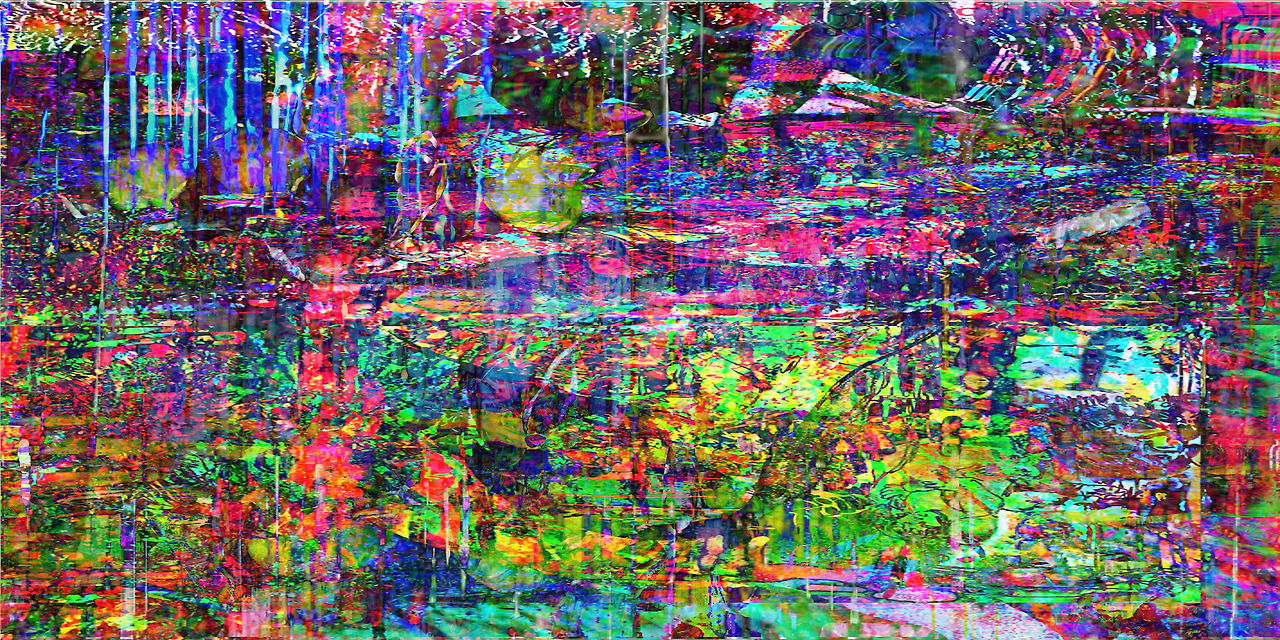
Desire Concept Realistic Abstract Work: Louis Choi chuljoo, bamboo forest i267-a portrait of a mirror reflecting its desire on the window-pond-mirror: [The interpretation of words in a cartoon news ː l’interprétation du mot dans une nouvelle caricature] Choi Chul-joo, a current affairs critic, was a reporter at the Ministry of Culture of the News Busan Internet Newspaper. He is a cultural design critic and abstract artist who paints Current affairs cartoon cartoons News and abstract paintings in contemporary :art works and webtoons. ■ Choi Chul-joo's concept of desire, "morning glory," conflicts with linguistic concepts of meaning emphasized from a metaphysical philosophical point of view, creating dramatic event images to express the subject of insufficient desire, and illuminating the image in reversible shades of white light. He reflects the linguistic grammatical meaning of abstract desire concepts as images to form spaces of multiple event images that share superimposed temporality and reversible white light shades. This is interpreted as the subject of the absence of desire beyond the abstract self of the desire of others rather than physical perception, unlike the materialism of painting in the 18th century. The linguistic grammatical meaning of abstract desire concepts is a dualistic object that regards real images as events, equating the structure of insufficient desire with the principle of spatial composition. And as reversible light at the point of light over time, the material is made into a real image as an object. Thus, the concept of abstract desire in a pond that reflects the image of an event is expressed as a real image that reflects the desires of others in the real world. ■ Choi Chul-joo's Concept of Desire Formula: In the concept of Choi Chul-joo's desire, mathematical desire as an axiom of logic in the concept of desire results in reality as a concrete phenomenon rather than based on the external structure of the linguistic meaning through abstract design. Therefore, the rendering of the desire structure revealed by abstract encounter with reality at the intersection of desire outside the window applies the mathematical desire concept abstract design, or the image of the desire concept, to the Choi Chul-joo desire formula, and on March 1, 2022, morning glory appears as a flat real image as the subject of desire as a reversible shade of light in the Flushing Town Hall (New York) exhibition./ The image of desire, which applies Choi Chul-joo's desire formula D(I...I')d=I(D...D')i to 'morning glory', connects the concept of desire with the background of 'morning glory' as an image to create a landscape by floating morning glory in the sky. In addition, in <morning glory>, the desire formula "D(I...I')d=I(D...D')i" is substituted, the connection effect between the concept of desire and the "morning glory" as desire image shades the concept of desire in the reversible shadow structure by setting the object as the concept of desire image of women by the "morning glory". In other words, the image of desire (I) is the structure of desire (D) because desire (D) is repeated (I...I') in several images (D...D'), and the image of art behavior or desire image(I) appears as the concept of desire(i). ■ Choi Chul-joo's Desire The design process of abstract concepts: 1. The concept of desire is abstracted from the perspective of an image to the outside of reality, and the image of reality as an object of abstraction is designed as the correlation between reality and reality. This is the design process 1 of Choi Chul-joo's concept of abstraction of desire. This does not presuppose a causal relationship with the real world, but rather results in an abstract concept of desire as a correlation with reality to escape the misunderstanding that transfers from an abstract concept to a real structure. 2. The scope of showing the concept of desire is created and located by omitting the actual size of the abstract concept as a shade of the concept of desire originating from the actual image. In addition, Choi Chul-joo's conceptual process 2 follows the process of decorating an object with a color of universal reality suitable for custom in order to have aesthetic value suitable for its position as a single image. This creates an abstraction that contrasts with the past and desire, in which the aesthetic structure hidden by realistic colors is divided by clouds and obscured by shaded light, obscuring the abstract concept in the actual image. 3. The subject who painted abstraction realizes the reality that symbolizes the concept of desire, and the unconscious realizes abstract desire as a conscious phenomenon of image. Desire is an abstract image realized as a conscious phenomenon of an image, and the unconscious structure is process 3 of designing an abstract art concept of desire that repeatedly designs desire that combines line and color in thoughts but is not conscious of unconscious behavior. 4. The unconsciously abstracted concept of desire is a piece of reality in which the object of reality is not seen as a reversible shade of light, concealing reality as a shadow and showing another real image as a video. This is the process 4 of designing an abstract concept of desire formed by combining the space of desire into a reversible light structure through the conscious movement of planar monochromatic painting carved into reality. ■ The Design Results of Choi Chul-joo's Desire Abstract Concept: Choi Chul-joo Desire Abstract Concept Design's Linguistic Meaning Results: Although the object that is obsessed with the desire for others is passive, it is possible to actively practice one's desires through the sympathizer as the subject of desire, and the sympathizer who sympathizes with the desires of others as the subject can practice with the same desire. As a subject, a person who sympathizes with or accepts the desires of others becomes the same desire and becomes another subject of execution. Here, the sympathizer who sympathizes with the subject of the other's desire tries to generalize it as another object of desire that acts like a victor of war. However, when desire as an act overshadowed by reversible light is not generalized as a public act, the subject of inappropriate desire and the sympathizer antagonize the subject who practiced it according to the other's general desire. ■ Object rendering of the concept of desire is 1. a pop art image that renders unconscious desire as an existential reality by dividing the same concept of desire as the event image into unconscious and real images as an object. Therefore, the subject who speaks linguistic meaning actually represents abstraction, the truth value of the concept of desire, which is an expressive aesthetic structure that specifies the viewing effect of colloquial language and event video broadcasting as an act of speech enunciation that depends on the news. 2. As the truth value of the concept of desire in visual images is an open system, and numerous visual images are transmitted to others through a pluralistic visual system. Abstract images, which are the true values of the concept of desire, attract attention because they have universality as real images expressed by the desires of others. In other words, the object exposed to the abstract desires of others functions as a desire to exchange the same aesthetic image as the concept of desire of others through the diachronic function of pop art applied as a work of art. 3. The truth value of the concept of desire in a linguistic sense in which the abstract image of the concept of desire and reality are the same, represents the structure of desire, and the reality of the abstract concept of desire is a real image, which is the causal structure of desire, and creates a structure of desire by forming a semantic relationship with contradictory desire. Like Kant, this is a dual structure up to modern art, and it encompasses mythical objects in the same structure as humans, and the antinomic desire structure as a single structure. 4. an object of the concept of desire rendered in abstraction: The object rendering of the concept of desire renders the object as an event image, which is the same rational object as the linguistic meaning of the desire structure through the gaze of the rational subject, is recognized as a real image that the subject cannot see. Additionally, other objects of desire are continuously represented by real images that attempt to fill the deficiency of desire. The pond, which reflects present desire as an object to abstract desire, presents a desire structure as a reality, which is an object to abstract desire, but it returns the cause of desire as a real image to an object as an event image, free from the imperfect abstraction that lacks desire that is subjugated to social visibility that has been concealed and deviated from lack through real images. In other words, the structure of deficiency and divided desire is hidden through real images of abstract desires, and contradictory desires subordinate to deviated social visibility become the cause of desire and become the objects of real images. In addition, object rendering of other desires is continuously expressed as a real image trying to fill the deficiency of desire. The rendering of an object that reflects the present desire as an object of abstract desire presents the structure of desire as reality, which is the object of abstract desire, but it returns the cause of desire as a real image to an object as an event image, away from the imperfect abstract lacking desire. In other words, the structure of deficiency and divided desire is hidden through the real image of abstract desire, and contradictory desires subordinate to deviated social visibility become the cause of desire, resulting in abstraction as a real image.
